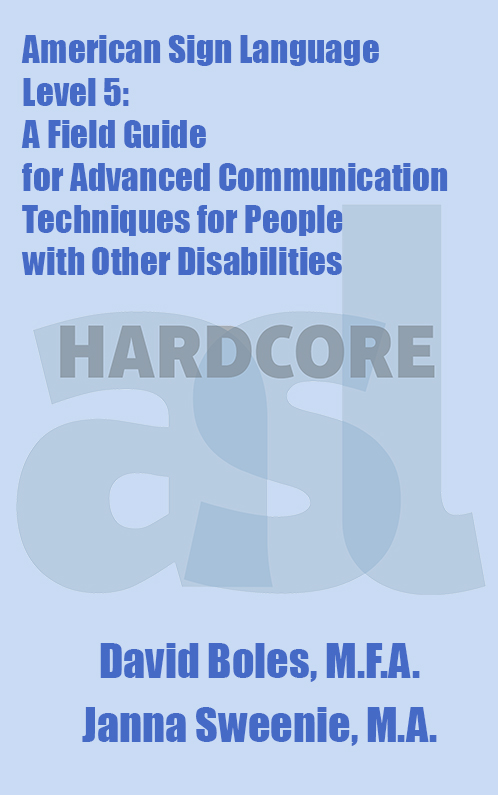Janna and I are pleased to announce our latest book is now available for purchase from Amazon — American Sign Language Level 5: A Field Guide for Advanced Communication Techniques for People with Other Disabilities written by David Boles, M.F.A. and Janna Sweenie, M.A. — yes, it’s an eyeful of a title, but that sort of specificity is necessary for this sort sort of real life ASL field guide.
BUY NOW!

Here’s the blurp from the opening of the handbook explaining the light and purpose of our work:
ASL is not just for Deaf People anymore. American Sign Language is actually a sophisticated communication meme with hundreds of applications for other disabilities that many overlook. We will provide footpaths for fresh discovery of interactive cross-disability communication. We are not teaching Baby Signs here. We are teaching ASL for those with Other Disabilities.
This is also a serious, scholarly, book with hard foundations in American Sign Language grammar, glossing and syntax — the teaching will also be fun and fresh and delightful.
While this book will be appropriate and reachable for every ASL learner, our top goal is serving the advanced, “ASL Level 5” professional and also mature signers like certified interpreters, other ASL instructors and ASL teaching programs as well as the Deaf and Other Disabled communities.
Over 85% of internet searches on our online multimedia teaching properties have some form of “ASL Level 5” as keywords searching for link results. We consider that empirical and quantitative proof that the phrase “ASL Level 5” proves a want for this book and that is the push that inspired us over the edge into this publication.
For over a decade, we have been working on an answer to that timely question — “Where is ASL Level 5?” — and the most fine-grained result are now in this 30,000 word handbook.
Here’s the chapters breakdown for American Sign Language Level 5: A Field Guide for Advanced Communication Techniques for People with Other Disabilities:
Chapter 1: Autism Spectrum Disorder (ASD), Apraxia of Speech, Pure Alexia without Agraphia and Down Syndrome
Chapter 2: Attention Deficit Disorder (ADD/ADHD), Language Learning Disabilities (LLD), Traditional Learning Disabilities (LD), Dyslexia and other Special Needs
Chapter 3: Low Vision, the Blind and the Deaf/Blind
Chapter 4: Cerebral Palsy, Multiple Sclerosis and Other Motor Impairments
Chapter 5: Amputation, Paralyzation, Limb Birth Defects and Broken Bones
Chapter 6: Hearing Impaired and the Non-Deaf Culture Deafened
Chapter 7: Brokering Dysfunctional Communication Dyads Between Parents, Average Siblings and Disabled Children and Adults
Chapter 8: Developing Communication Skills through ASL Play
Chapter 9: Tempering Classroom Communication Disconnects Between Teacher and Student
Chapter 10: Inventing New Methods and Excepting Technological Advancements, Plus a Note on Certified Deaf Interpreters (CDI)
We thank you for supporting our educational effort by purchasing our book — and we have a lot more books on a variety of topics being written and created for you right now.
Stay tuned for more news from David Boles Books Writing & Publishing!
Great to see the book is now available! Long process but a good result.
Yes, this book took years of planning and insight and experience to make happen. The results are unique and helpful, I think.
There isn’t another book like it. That’s for sure. The application of ASL to other disabilities is a unique and interesting niche.
Yes, and that’s what took so long — we needed real life, real time, experience to set up up the philosophy of, and ignite the applications in, the book!
Congratulations! This is an important and necessary book for our time!
Thanks, Gordon! It was definitely a challenge of a book to write. Some of it is linguistics common sense, some of it is innovative application of theory in critical communication dyads.